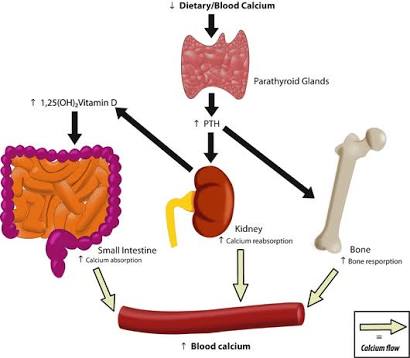
PARATHYROID HORMONE AND DISORDERS
Parathyroid hormone is the most important endocrine regulator of calcium and phosphorus concentration in extracellular fluid. This hormone is secreted from cells of the parathyroid glands and finds its major target cells in bone and kidney.
Parathyroid hormone accomplishes its job by stimulating at least three processes:
- Mobilization of calcium from bone: Although the mechanisms remain obscure, a well-documented effect of parathyroid hormone is to stimulate osteoclasts to reabsorb bone mineral, liberating calcium into blood.
- Enhancing absorption of calcium from the small intestine: Facilitating calcium absorption from the small intestine would clearly serve to elevate blood levels of calcium. Parathyroid hormone stimulates this process, but indirectly by stimulating production of the active form of vitamin D in the kidney. Vitamin D induces synthesis of a calcium-binding protein in intestinal epithelial cells that facilitates efficient absorption of calcium into blood.
- Suppression of calcium loss in urine: In addition to stimulating fluxes of calcium into blood from bone and intestine, parathyroid hormone puts a brake on excretion of calcium in urine, thus conserving calcium in blood. This effect is mediated by stimulating tubular reabsorption of calcium. Another effect of parathyroid hormone on the kidney is to stimulate loss of phosphate ions in urine.
Parathyroid hormone is released in response to low extracellular concentrations of free calcium. Changes in blood phosphate concentration can be associated with changes in parathyroid hormone secretion. When calcium concentrations fall below the normal range, there is a steep increase in secretion of parathyroid hormone. Low levels of the hormone are secreted even when blood calcium levels are high.
Both increased and decreased secretion of parathyroid hormone are recognized as causes of serious disease in man and animals.
Excessive secretion of parathyroid hormone is seen in two forms:
- Primary hyperparathyroidism is the result of parathyroid gland disease, most commonly due to a parathyroid tumor (adenoma) which secretes the hormone without proper regulation. Common manifestations of this disorder are chronic elevations of blood calcium concentration (hypercalcemia), kidney stones and decalcification of bone.
- Secondary hyperparathyroidism is the situation where disease outside of the parathyroid gland leads to excessive secretion of parathyroid hormone. A common cause of this disorder is kidney disease - if the kidneys are unable to reabsorb calcium, blood calcium levels will fall, stimulating continual secretion of parathyroid hormone to maintain normal calcium levels in blood. Secondary hyperparathyroidism can also result from inadequate nutrition - for example, diets that are deficient in calcium or vitamin D, or which contain excessive phosphorus (e.g. all meat diets for carnivores). A prominent effect of secondary hyperparathyroidism is decalcification of bone, leading to pathologic fractures or "rubber bones".
Inadequate production of parathyroid hormone - hypoparathyroidism - typically results in decreased concentrations of calcium and increased concentrations of phosphorus in blood. Common causes of this disorder include surgical removal of the parathyroid glands and disease processes that lead to destruction of parathyroid glands. The resulting hypocalcemia often leads to tetany and convulsions, and can be acutely life-threatening. Treatment focuses on restoring normal blood calcium concentrations by calcium infusions, oral calcium supplements and vitamin D therapy.
By the end of this lessons, students should know about
- Functions of parathyroid hormone
- control of parathyroid secretion
- hypoparathyroidism
- hyperparatgyroidism


